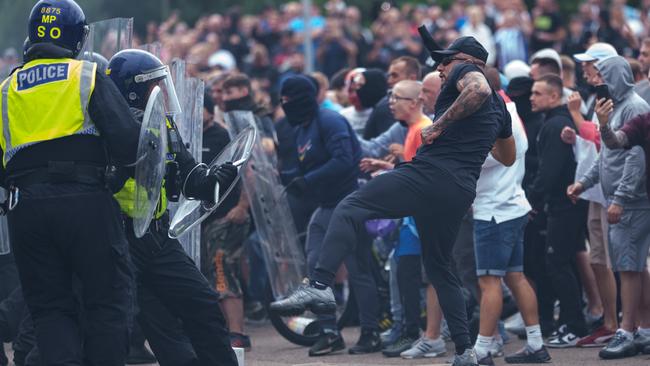Higher terror alert reflects divisions driven by hate

Terrorists were being radicalised at a younger age, and their path towards violence had become more rapid as misinformation and conspiracy theories proliferated online. The challenge was being exacerbated, Mr Burgess said, by the internet and social media – the primary platform for radicalisation – and the use of encryption “by every single one of our investigative subjects”. That points to the need for accountability on the part of global tech giants, which control algorithms that facilitate the spread of misinformation and encrypted text message systems. These are operated to huge financial advantage, and play into terrorists’ and criminals’ hands.
That is evident in Britain, where violent protests have spread rapidly from the north of England to Belfast and London after false claims on social media that Axel Rudakubana, 17, born to Rwandan migrant parents in Wales, was a Muslim asylum-seeker on a security watchlist. Rudakubana allegedly stabbed three little girls aged six, seven and nine, and wounded 10 others at a Taylor Swift-themed dance and yoga session in Merseyside last week. As The Times noted, social media platforms have become hatemongers directing inchoate anger and frustration: “Millions of people hourly check the latest posts on TikTok, Instagram, Telegram, Twitter/X and those other platforms that appear to dominate the thinking and actions of the gullible and the malign.”

The lifting of Australia’s terror threat was no surprise. While sobering, it was long overdue. Underlying violent tensions have been evident for 10 months. They emerged in the jubilant celebrations in western Sydney the day after the October 7 terror attacks in Israel, and continued at the appalling anti-Semitic protest at the Opera House forecourt on October 9. They again surfaced in the hate sermons of extremist Islamist preachers in western Sydney and in the stabbing of Bishop Mar Mari Emmanuel by a 16-year-old. Countless hate-filled demonstrations against Jews in Melbourne and campus protests at universities were all part of the trend. As Anthony Albanese said at Monday’s press conference with Mr Burgess, Australia’s security environment has become far more volatile and unpredictable. The Prime Minister has been locked out of his Sydney electorate office for much of the year due to safety concerns caused by pro-Palestinian protesters. In June, he denounced the blockades, which he said were supported by Greens senators and state Greens. The Greens’ hostility to Israel and its supporters has grown alarmingly blatant, with deputy leader Mehreen Faruqi refusing to say that terrorist group Hamas should be dismantled.
As Mr Albanese said on Monday: “It is not normal to have people in occupations for months outside electorate offices, where the work of those electorate offices is to assist people in social security and health and other areas.” Governments around the world, he said, are “concerned about youth radicalisation, online radicalisation and the rise of new mixed ideologies”. But Mr Burgess’s suggestion of some kind of equivalence between the levels of anti-Semitism and Islamophobia is not borne out by reality. “It’s kind of, almost, equal treatment. Not quite, but almost equal treatment,” he said.
For Australia, and much of the world, the elevated terror threat will be no passing phase. It is symptomatic of uglier, angrier societies in which divisions are sharpened by the sewer of social media. In the face of these factors, government and security authorities should not shy away from pointing out that the greatest threats are likely to arise from anti-Semitic Islamist extremism.


On the day when ASIO raised the terrorism threat level in Australia from “possible” to “probable” for the first time since 2014, significant lessons need to be learned from Britain, where social cohesion and security are under threat from violent extremism inflamed by irresponsible social media. ASIO’s move follows eight attacks or disruptions of terror plots since April, with the Israel-Hamas war deemed to be just one of the contributing factors. Provocative inflammatory behaviours were being normalised, ASIO director-general Mike Burgess warned: “This trend increased during Covid and gained momentum after the terrorist attacks on Israel, and accelerated during Israel’s military response. The dynamics are raising the temperature of the security environment.”